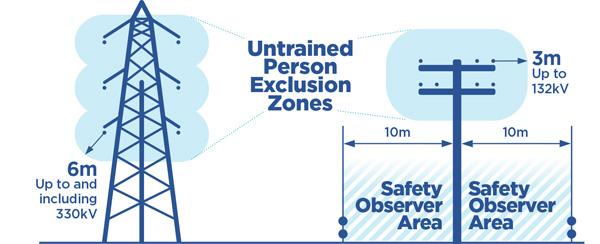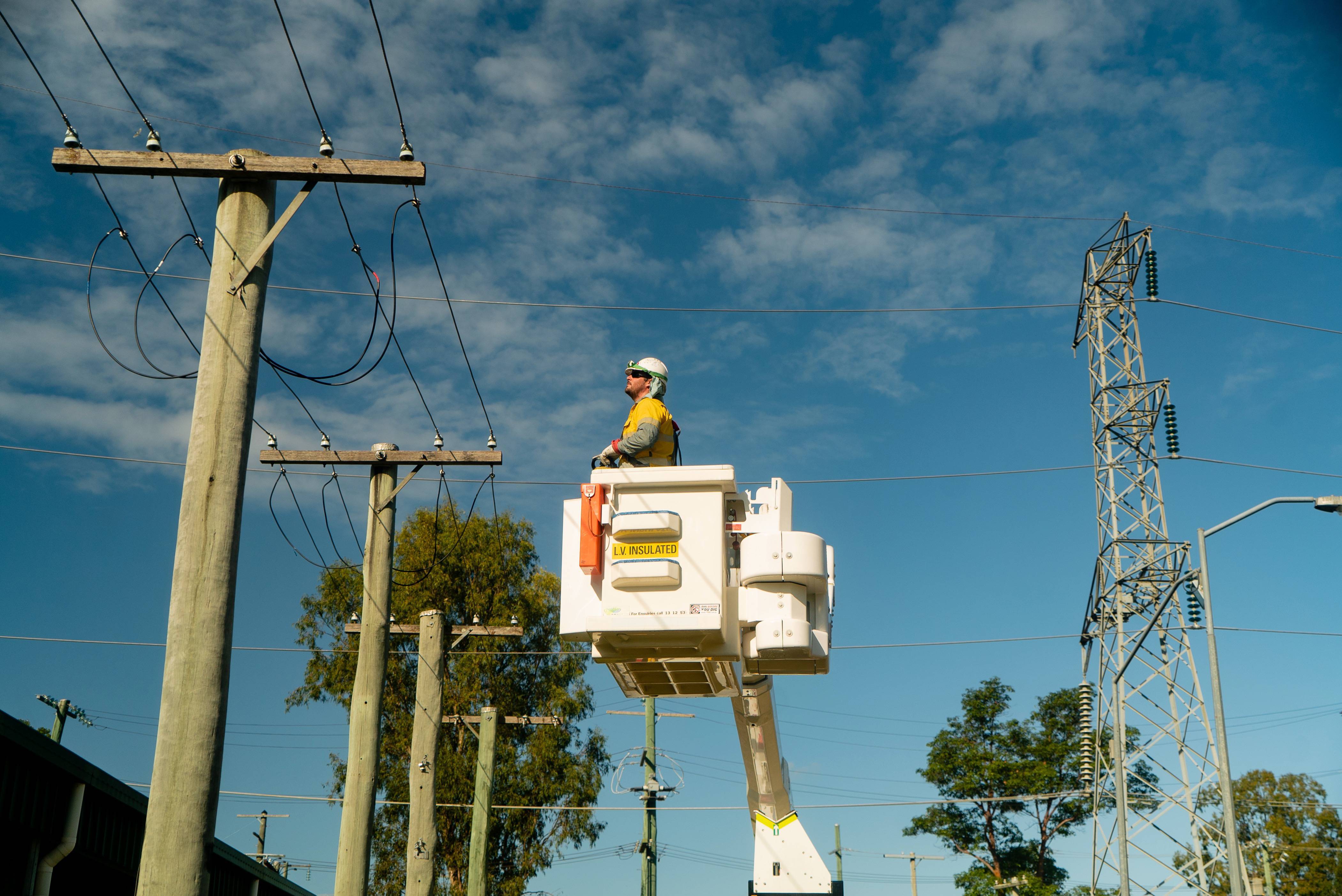Exclusion zones & safety laws
Exclusions zones keep people, operating plant and vehicles a safe distance from energised overhead powerlines. No part of a worker, operating plant or a vehicle should enter an exclusion zone while the overhead powerline is energised (live).
What’s an exclusion zone?
An exclusion zone is a minimum safe distance that must be kept from powerlines to reduce the risk of electric shock. People, operating plant and vehicles must stay out of an exclusion zone while an overhead powerline is energised or live.
The size of an exclusion zone depends on the voltage of the powerline, the type of work being done, and the qualifications of people involved.
Generally, exclusion zones are:
- 3 metres for voltages up to 132kV
- 6 metres for voltages up to 330kV

Note: These distances can be reduced if a worker is approved as an Authorised Person. Find out how to become an Authorised Person.
IMPORTANT: If you have to enter an exclusion zone, contact us to request written Safety Advice. You can’t enter the zone until you have that advice.
Know your exclusion zones
Skip to descriptionWhat is your exclusion zone?
An exclusion zone is an invisible ‘safety envelope’ that surrounds an overhead power line. These ‘no go’ areas represent the minimum safe distance that must be maintained by any person, vehicle or piece of equipment to reduce the risk of electric shock.
No part of a worker, vehicle or piece of equipment should enter the exclusion zone while the overhead powerline is live.
The radius of the exclusion zone depends on the voltage of the powerline, the type of work being performed, and the qualifications of the people performing the work.
The most common exclusion zones are:
- 3 metres for voltages up to 132kV
- and 6 metres for voltages up to 330kV.
However, the radius of the exclusion zone can be reduced if workers performing the work on the power line have been trained and approved as an Authorised Person.
Always seek safety advice if your work has the potential to cross into powerline exclusion zones.
Before starting work take the time to plan.
Download the Look up and live app or contact us for more information and advice on exclusion zones and working safely around powerlines.
Know your exclusion zones
This video explains that an exclusion zone is an invisible ‘safety envelope’ that surrounds an overhead power line. These ‘no go’ areas represent the minimum safe distance that must be maintained by any person, vehicle or piece of equipment to reduce the risk of electric shock.
Safety observer
Skip to descriptionA Safety Observer, sometimes known as a spotter, is a person who watches over machinery or equipment in use in high risk situations. Their job is to alert the operator if any part of the machinery or equipment is at risk of entering an overhead powerline exclusion zone.
Safety Observers undergo specific training and must be competent to perform the role in observing, warning and communicating effectively with the machinery or equipment operator.
So, when do you need to use a safety observer?
Anytime there is the possibility of machinery or equipment reaching or entering an exclusion zone a trained Safety Observer MUST be appointed.
When a trained Safety Observer is appointed a Safety Observer Zone can be set up 10 meters either side of overhead powerlines. A Safety Observer Zone is an area where machinery or equipment is allowed to operate even if any part of the machinery or equipment COULD enter the powerline exclusion zone.
Before starting work take the time to plan.
Visit our website or contact us for more information about Safety Observers, Safety Observer Zones, or to order industry specific safety materials to help you and your team work safely around powerlines.
When to use a safety observer
This video explains that a Safety Observer, sometimes known as a spotter, is a person who watches over machinery or equipment in use in high risk situations. Their job is to alert the operator if any part of the machinery or equipment is at risk of entering an overhead powerline exclusion zone.
Look up and Live map
Our Look up and Live map helps you locate overhead powerlines using an interactive geospatial map. It also gives you:
- safety guidelines and advice, including powerline exclusion zones
- options for planning or performing work e.g. powerline visual indicators
- information on de-energisation or relocation of powerlines
- high load forms
- Before You Dig Australia enquiry details.
You can also download this map as the Look up and Live app.
 |  |
|---|
Electrical safety laws
Several laws apply when you work with or around powerlines. They’re designed to prevent people and property from being harmed or damaged by electricity. These include:
- Electrical Safety Act 2002
- Electrical Safety Regulation 2013
- Work Health and Safety Act 2011
- Work Health and Safety Regulation 2011
- Codes of Practice approved under the above-mentioned Acts.
If you are an employer, getting to know these laws will help you understand your obligations. It’s your responsibility to keep your workers safe.
How to comply
Use the Electrical Safety Code of Practice 2020 - Working near overhead and underground electric lines for practical advice to help you apply the laws in your place of work. It outlines a process for:
- identifying hazards
- assessing the risks associated with these hazards
- implementing and maintaining risk control measures
- reviewing risk control measures
Before you work near electricity, you should take some time to identify electrical hazards. Plan ahead and check the location of powerlines with our Look up and Live map, which you can also download from app stores.
The following are examples of activities that can pose a risk when done near powerlines.
Overhead powerlines
- operating machinery such as cranes, tip trucks, cane harvesters, elevated work platforms, fork lifts, grain augers, excavators and irrigators
- putting up advertising signs or billboards
- building work, scaffolding or demolition
- pruning or felling trees or vegetation
- painting fascia, replacing roofing, guttering or external cladding near service line point of attachment to a building
- dam construction or levee bank earthworks.
Underground powerlines
- digging and excavating
- sawing
- trenching
- under boring
- sinking boreholes
- earth works
- laying cables and pipes
- driving implements into the ground such as star pickets and fence posts.
If you’re carrying out hazardous activities, assess how likely it is that:
- a worker will be injured
- property, plant or equipment will be damaged
- you’ll come within an unsafe distance of an electric line.
Refer to the Electrical Safety Code of Practice 2020 - Working near overhead and underground powerlines for more detail about how to assess risks.
Ideally, you should eliminate the risks associated with working near powerlines. If you can’t eliminate risks completely, you need to at least minimise them. Control measures, in order of effectiveness, include:
- De-energising the overhead network
- Relocating the overhead network
- De-energising the underground network
- Relocating the underground network
- placing physical barriers to stop entry to exclusion zones
- using powerline visual indicators e.g. rota markers
- appointing a safety observer
- delineating and setting up a safety observer area.
If you’re working or operating plant near any overhead or underground electric lines, you should also refer to the Electricity Entity Requirements: Working Near Overhead and Underground Electric Lines (PDF 681.8 kb).
The electrical safety codes of practice that might apply to your place of work:
- Electrical Safety Code of Practice 2020-Electrical equipment rural industry
- Managing electrical risks in the workplace code of practice 2021
- Electrical Safety Code of Practice 2020-Working near overhead and underground electric lines
- Electrical Safety Code of Practice 2020-Works
- Managing the risks of plant in the workplace Code of Practice 2021
- Mobile crane Code of Practice 2024
- Tower crane Code of Practice 2017
Want more information?
FAQs
If you have more questions, you might find answers in our Safety Frequently Asked Questions.
Safety fact sheets
Download our fact sheets for information about working safely near powerlines, including some specific guidelines for different industries.
- Agriculture industry (PDF 1.6 mb)
- Building and construction industry (PDF 1.6 mb)
- Buildings, structures and billboards (PDF 1.4 mb)
- Cotton industry (PDF 1.6 mb)
- Fire and high voltage powerline safety (PDF 1.4 mb)
- Look up and Live - Exclusion zones (PDF 624.9 kb)
- Low-level flying (PDF 1.4 mb)
- Marking overhead powerlines and electrical assets (PDF 1.8 mb)
- Plumbing industry (PDF 1.3 mb)
- Sugar cane farms (PDF 2.0 mb)
- Trees and powerlines (PDF 1.8 mb)
To order factsheets in industry packs, use our online brochure & sticker order form.
Marking powerlines on your property
Find out about powerline markers and how to increase the visibility of powerlines on your property. This is especially important if there are low level flying operations on your property or if machinery is operated near powerlines.

